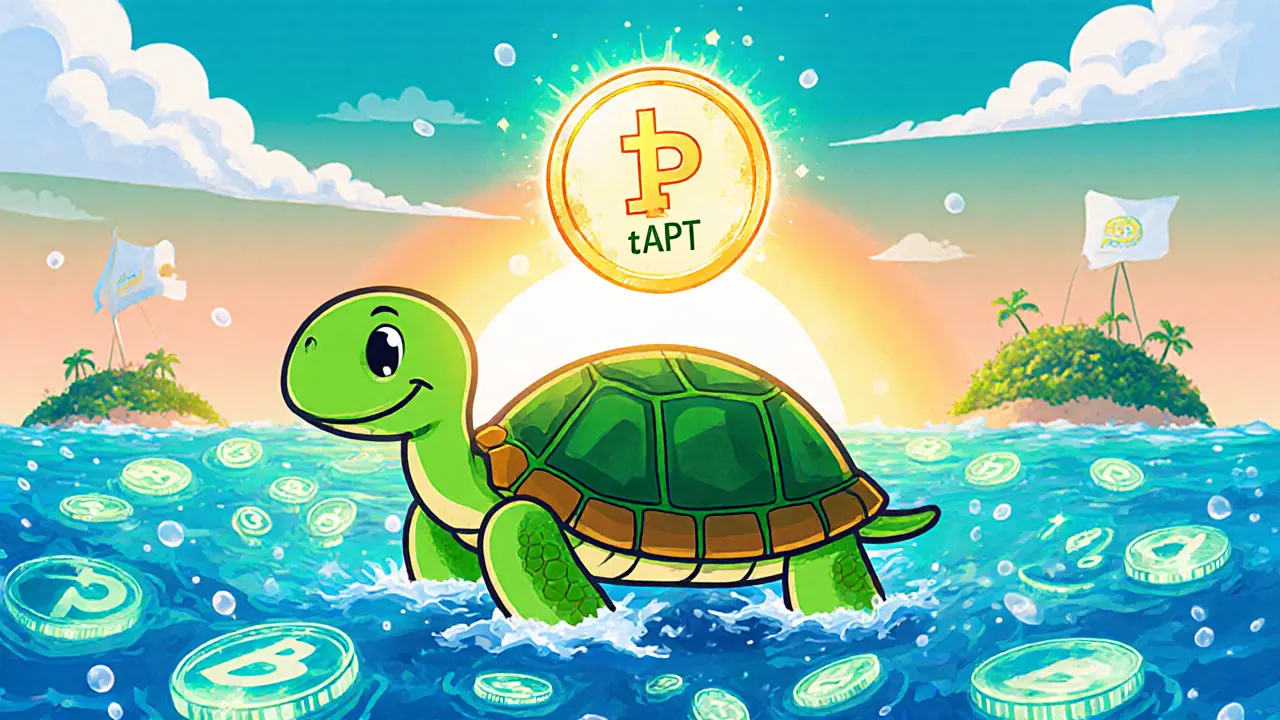tAPT Staking Calculator
Stake Your APT, Earn Rewards
Your Staking Results
Ever wondered why you can’t stake your Aptos (APT) without locking up a small fortune? tAPT changes that game, letting anyone earn staking rewards with just a few APT. Below you’ll find everything you need to know about this liquid‑staking derivative - from how it’s built to where you can trade it today.
Key Takeaways
- tAPT is a liquid staking token issued by Tortuga Finance on the Aptos blockchain.
- It lets users stake any amount of APT without the 1million‑APT validator minimum.
- Each tAPT represents a proportional share of staked APT plus accumulated rewards.
- Current price hovers around $4.5, with a market cap of roughly $80k.
- Liquidity is growing but remains lower than Ethereum’s stETH; expect higher slippage on large trades.
Tortuga Finance Aptos (tAPT) is a liquid staking derivative token that represents staked Aptos (APT) assets while keeping them tradable. Launched in 2024, the protocol was created to solve a painful reality: Aptos validators demand a minimum of 1million APT - roughly $5million at today’s rates - to run a node. For most retail holders, that barrier is impossible. Tortuga Finance abstracts the complexity, offering one‑click staking and a token that can move freely across DeFi.
What Exactly Is tAPT?
In plain terms, when you deposit APT into Tortuga’s web app, the platform locks your coins in a validator and mints an equal amount of tAPT. Over time, the tAPT‑to‑APT exchange rate rises as staking rewards accrue. Think of it like a receipt that grows in value while you hold it.
Key attributes of tAPT:
- Chain: Aptos (uses the Move language for smart contracts).
- Supply: 18,074.52 tokens circulating (Oct2025).
- Price range (Oct2025): $4.46‑$6.23 across exchanges.
- Market cap: about $80,600.
- Fees: No platform staking fee; only standard Aptos transaction fees.

How tAPT Works Under the Hood
The protocol’s technical backbone lives on Aptos, written in Move Aptos’s native smart‑contract language designed for safety and parallel execution. The contract address is 0x84d7aeef42d38a5ffc3ccef853e1b82e4958659d16a7de736a29c55fbbeb0114::staked_aptos_coin::StakedAptosCoin, verified by P2P.Army A blockchain explorer that tracks contract deployments on Aptos.
Here’s a step‑by‑step flow:
- Connect an Aptos‑compatible wallet (Petra, Pontem, etc.) to app.tortuga.finance.
- Deposit any amount of APT - even just 10APT.
- The platform stakes the APT on a validator and instantly mints tAPT 1:1.
- Rewards accrue; the contract updates the internal exchange rate (e.g., 1tAPT = 1.003APT after one week).
- You can hold, trade, or use tAPT in other DeFi protocols while still earning rewards.
Because tAPT remains liquid, you can provide it as collateral on Ben32 An Aptos lending protocol that accepts tAPT as collateral or add it to liquidity pools on Liquidswap A decentralized exchange on Aptos.
Benefits and Risks of Using tAPT
Why would you pick tAPT over direct APT staking? Here are the pros and cons that most users mention on Reddit and Trustpilot.
| Feature | tAPT (Aptos) | Direct APT Staking | Lido stETH (Ethereum) |
|---|---|---|---|
| Minimum stake | 1APT (any amount) | 1million APT | 32ETH |
| Liquidity | Tradeable on 44 markets; moderate depth | Locked until unbonding period | Highly liquid, >$100M daily volume |
| Reward rate | Matches Aptos validator earnings (~5‑7% APY) | Same as tAPT (direct validator share) | Similar to Ethereum staking yields |
| Fees | No protocol fee; only network gas | Network gas only | Lido takes ~10% of rewards |
| Security audit | None publicly released (as of Oct2025) | Secured by Aptos consensus | Multiple third‑party audits |
In short, tAPT shines for accessibility and composability, but its liquidity and audit transparency lag behind more mature solutions.
Current Market Data (Oct2025)
Pricing varies a bit:
- CoinGecko: $4.51
- Dropstab: $4.46
- Liquidity Finder (May2025 snapshot): $6.23
Trading volume shows a huge spread - CoinGecko reported $81,228 in 24h, while other sites listed under $4,000. The biggest venue is Gate.io A crypto exchange that lists tAPT/USDT with the highest daily volume, moving about $81,097 in 24h.
With a circulating supply of just over 18k tokens, the overall market cap stays under $0.1M, a fraction of the $11.2B Aptos ecosystem. Still, the token’s supply grew 247% from January to October 2025, indicating rapid adoption among retail APT holders.

How to Get Started with tAPT
If you’re ready to try it, follow these simple steps. No need to be a dev - just a wallet and a few APT.
- Install a compatible wallet (Petra is the most user‑friendly).
- Buy or transfer APT into the wallet; keep 0.5‑1APT for gas.
- Visit app.tortuga.finance and connect your wallet.
- Enter the amount of APT you want to stake and confirm the transaction.
- After the transaction finalizes (usually a few seconds), you’ll see the same amount of tAPT in your wallet.
- Optional: Bridge tAPT to a DEX like Liquidswap if you plan to trade or provide liquidity.
Most users report completing these steps in under 15minutes. The biggest hiccup is network congestion - during peak hours gas can spike to 0.5APT ($2.50), so timing your transaction can save a few dollars.
Future Roadmap and Outlook
Tortuga Finance isn’t standing still. Their public roadmap outlines version2.0 (launched Aug2025) with faster reward distribution and a plan for cross‑chain bridges by Q22026. Integration with new lending platforms (e.g., Ben32 A DeFi lending protocol on Aptos that added tAPT as collateral) expands use‑cases beyond simple holding.
Analysts at Messari expect Aptos liquid‑staking derivatives to capture 15‑20% of total staked assets within two years. If that materializes, tAPT’s market cap could multiply tenfold, taking it into the $800k-$1M range. However, regulatory headwinds (SEC scrutiny of staking derivatives) and the relative youth of Aptos’s network remain uncertainties.
Frequently Asked Questions
What is the difference between tAPT and APT?
tAPT is a token that represents staked APT plus earned rewards. While APT is the native coin, tAPT stays liquid and can be traded or used in DeFi.
Do I need to lock up a minimum amount of APT?
No. The protocol lets you stake as little as 1APT - even fractions if your wallet supports them.
Can I withdraw my APT instantly?
You can redeem tAPT for APT at any time, but you must pay the normal Aptos network transaction fee. During heavy traffic, the fee may rise.
Is tAPT safe without a formal audit?
Security relies on Aptos’s consensus and the contract code, which developers consider clean. However, the lack of an independent audit adds a layer of risk.
Where can I trade tAPT?
tAPT is listed on about 44 markets. The most liquid pairs are on Gate.io, Liquidswap, and AUX Exchange. Centralized exchanges like Binance do not list it yet.




18 Comments
VEL MURUGAN
While tAPT looks shiny, the lack of an audit is a glaring red flag; investors should be wary of the so‑called "liquidity" that still hinges on a single bridge. The promise of instant redemption feels more like a marketing gimmick than a proven mechanism. Proceed with caution.
Russel Sayson
Let me lay it out in stark terms: tAPT is pitching itself as the future of liquid staking, yet its foundation is still a fragile prototype. The reported APY mirrors Aptos validator earnings, which barely scratches the surface of what true DeFi innovation can deliver.
First, the absence of a public audit is not a minor oversight; it’s a massive transparency gap that should alarm any serious investor.
Second, the liquidity pools on Gate.io and Liquidswap are thin enough that a modest sell‑off could trigger severe slippage, eroding any earned rewards.
Third, the token’s supply has ballooned by 247% this year, suggesting a rush of speculative inflow rather than organic, sustainable growth.
Fourth, the roadmap touts cross‑chain bridges by Q2 2026, but those are still speculative milestones that may never materialize.
Fifth, regulatory scrutiny of staking derivatives is intensifying, and tAPT could become a target for compliance actions.
Sixth, the network gas fees, while low now, can spike dramatically during congestion, adding hidden costs to redemption.
Seventh, the token’s market cap remains under $0.1 M, making it vulnerable to manipulation by whales.
Eighth, the community governance mechanisms are under‑developed, leaving decision‑making in the hands of a few core developers.
Ninth, the lack of a Multi‑Sig treasury raises questions about fund security.
Tenth, the tokenomics do not clearly allocate a portion of fees to a safety fund, unlike more mature platforms.
This isn’t to say tAPT has zero merit-it does offer a convenient on‑ramp for APT holders reluctant to lock assets for long periods.
However, the risk‑reward balance tilts heavily toward risk at this stage.
Potential investors should demand an independent audit, clearer liquidity incentives, and a concrete timeline for regulatory compliance before jumping in.
Isabelle Graf
If you think pumping tAPT is a virtue, you’re mistaking hype for honesty.
Shane Lunan
Yo the audit thing is real but many projects skip it and still work fine
Jeff Moric
I get where you’re coming from; it’s always good to stay critical while also giving promising tech a chance.
Jordan Collins
Could you elaborate on how the projected ten‑fold market cap aligns with historical Aptos staking derivative growth patterns?
Ken Lumberg
Putting faith in an un‑audited token is ethically dubious; the community deserves transparency.
Blue Delight Consultant
One might argue that trust is a social contract, yet without audit it is a contract built on sandz.
Wayne Sternberger
I see ur point but maybe we shoud slook at the actual on‑chain data before dismissing it.
Gautam Negi
Everyone’s singing praises of tAPT, but I see the storm brewing behind that glossy veneer.
Shauna Maher
Don’t be fooled; the whole thing is a front for the big guys to control Aptos staking power.
Kyla MacLaren
Yeah that’s a good q but i think the numbers are still kinda hazy.
Linda Campbell
From an American perspective, supporting domestic staking solutions like tAPT strengthens our crypto sovereignty.
John Beaver
Thats a solid point, actually deffinitely adds to the case for tapt.
Jennifer Bursey
Leveraging liquid staking derivatives such as tAPT can optimize yield curves within the DeFi stack.
Maureen Ruiz-Sundstrom
Yet that buzzword‑laden optimism neglects the ontological risk of embedding unverified code into capital allocation.
Kevin Duffy
Hey folks, if you’re on the fence, give tAPT a try – it’s a fun experiment and you might learn a lot! 😊🚀
Jazmin Duthie
Sure, because every experiment ends in profit, right?